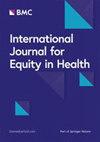Rural–urban differences in health service utilization in upper-middle and high-income countries: a scoping review
IF 4.5
2区 医学
Q1 PUBLIC, ENVIRONMENTAL & OCCUPATIONAL HEALTH
引用次数: 0
Abstract
This scoping review aims to understand the extent and attributes of literature evaluating differences between rural and urban populations’ utilization of health services in upper-middle and high-income countries. The review was conducted in line with established scoping review methodology guidelines. We used the “Participants, Concept and Context” framework to guide the inclusion criteria and determination of the review’s scope. Studies published over a 15-year period (2008–2022) were identified using Embase, Medine, PubMed, and Scopus databases. Study attributes, areas of focus and findings were reviewed and extracted. The search identified 179 studies. The number of studies published looking at rural–urban differences in health service utilization has increased over time. The focus of these studies is relatively evenly split between primary and secondary sectors. The majority of studies observed less service utilization by rural populations than urban—especially so in primary-sector services. When higher rural utilization of secondary services was observed this was frequently attributed to poor access to other services that would have had the potential to mitigate the secondary demand. Studies were not commonly grounded in principles of equity or fairness and rarely offered value judgements on observed differences in utilization. There were limited system-level studies – the vast majority being disease- or service-specific analyses. We consider this a notable gap in the literature. This scoping review identifies key parameters of studies on rural–urban variation in health service utilization. The finding that most studies observed rural populations utilized comparatively less services is concerning, in the context of general evidence about high levels of health need in rural communities. Future system-level research considering the combined variations in need and utilization appears a priority.中上收入和高收入国家在医疗服务利用方面的城乡差异:范围界定审查
本范围界定综述旨在了解评估中上收入和高收入国家城乡居民利用医疗服务差异的文献的范围和属性。综述按照既定的范围界定综述方法指南进行。我们使用 "参与者、概念和背景 "框架来指导纳入标准和确定综述范围。我们使用 Embase、Medine、PubMed 和 Scopus 数据库确定了 15 年内(2008-2022 年)发表的研究。对研究属性、重点领域和研究结果进行了审查和提取。搜索共发现 179 项研究。随着时间的推移,有关城乡医疗服务利用率差异的研究发表数量有所增加。这些研究的重点相对平均地分布在第一产业和第二产业。大多数研究发现,农村人口对服务的利用率低于城市人口,尤其是在第一产业服务方面。当观察到农村人口对第二产业服务的利用率较高时,这往往被归因于他们难以获得其他服务,而这些服务本有可能缓解第二产业的需求。研究通常不以公平或公正原则为基础,也很少对观察到的利用率差异作出价值判断。系统层面的研究非常有限,绝大多数都是针对具体疾病或服务的分析。我们认为这是文献中的一个明显空白。本范围界定综述确定了有关城乡医疗服务利用差异研究的关键参数。大多数研究发现,农村人口使用的服务相对较少,这一发现令人担忧,因为有普遍证据表明,农村社区的健康需求水平较高。未来系统层面的研究应优先考虑需求和利用率的综合差异。
本文章由计算机程序翻译,如有差异,请以英文原文为准。
求助全文
约1分钟内获得全文
求助全文
来源期刊

International Journal for Equity in Health
Medicine-Health Policy
CiteScore
7.80
自引率
4.20%
发文量
162
审稿时长
28 weeks
期刊介绍:
International Journal for Equity in Health is an Open Access, peer-reviewed, online journal presenting evidence relevant to the search for, and attainment of, equity in health across and within countries. International Journal for Equity in Health aims to improve the understanding of issues that influence the health of populations. This includes the discussion of political, policy-related, economic, social and health services-related influences, particularly with regard to systematic differences in distributions of one or more aspects of health in population groups defined demographically, geographically, or socially.
 求助内容:
求助内容: 应助结果提醒方式:
应助结果提醒方式:


